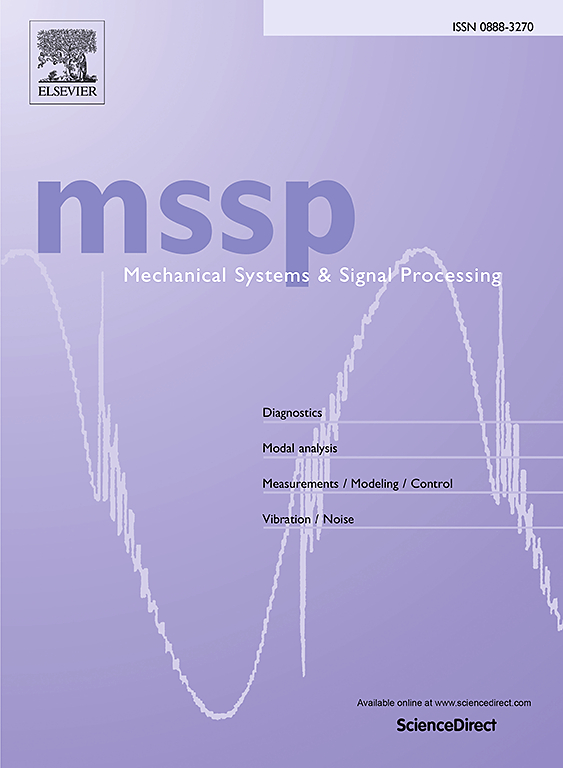TC4钛合金磨损特性的非线性超声瑞利波检测:与残余应力的相关性
IF 7.9
1区 工程技术
Q1 ENGINEERING, MECHANICAL
引用次数: 0
摘要
TC4钛合金因其优异的性能特性而广泛应用于机械系统,但由于摩擦磨损导致体积损失和残余应力,最终影响系统性能和可靠性,因此TC4钛合金面临着不可避免的挑战。本研究采用非线性超声瑞利波技术,结合白光干涉检测和x射线衍射检测,系统地检测了TC4钛合金在正常载荷(0-100 N)、磨损周期(0-6000周期)、位移幅值(0-4 mm)等不同工况下的干摩擦磨损行为。白光干涉检测和x射线衍射检测结果表明,表面形貌特征、磨损体积、磨损深度和残余应力随正常载荷、磨损周期和位移幅度成正比增加。这些参数与增强的非线性瑞利效应相关,表现为二次/三次谐波(4 MHz/6 MHz)和基波为2 MHz的零频率分量。二、三次谐波非线性系数随磨损参数的增大而单调增大。与零频率测量相比,第二/第三谐波分量表现出优越的灵敏度。值得注意的是,非线性系数主要受残余应力而不是磨损深度或体积的影响。对压痕深度参数(0/40/55/65/80 μm)和材料非线性程度为2 ~ 5倍的不同磨损残余应力状态的非线性超声数值模拟证实了上述实验结果。研究发现,超声非线性系数是磨损过程中残余应力的有效指标,可以定量评估磨损严重程度,便于非线性超声技术的原位无损评价。本文章由计算机程序翻译,如有差异,请以英文原文为准。
Nonlinear ultrasonic Rayleigh wave detection of wear characteristics in TC4 titanium alloy: Correlation with residual stress
TC4 titanium alloy, widely utilized in mechanical systems due to its exceptional performance characteristics, faces inevitable challenges from frictional wear that results in volume loss and residual stresses, ultimately compromising system performance and reliability. This investigation systematically detects the dry friction wear behavior of TC4 titanium alloy under different conditions of normal load (0–100 N), wear cycles (0–6000 cycle), and displacement amplitudes (0–4 mm) by nonlinear ultrasonic Rayleigh wave technology in combination with white light interferometric detection and X-ray diffraction detection. Results demonstrate that surface morphology characteristics, wear volume, wear depth, and residual stress exhibit proportional increases with normal load, wear cycles, and displacement amplitude by white light interferometric detection and X-ray diffraction detection. These parameters correlate with enhanced nonlinear Rayleigh effects, manifesting in second/third harmonic (4 MHz/6 MHz) and zero frequency components with fundamental wave of 2 MHz. The ultrasonic nonlinear coefficients of the second and third harmonics increase monotonically with the increase of the wear parameter. And second/third harmonic components demonstrate superior sensitivity compared to zero frequency measurements. Significantly, the nonlinear coefficient is predominantly influenced by residual stress rather than wear depth or volume. Numerical simulations of nonlinear ultrasonics with indentation depth parameters (0/40/55/65/80 μm) and the 2–5 times material nonlinearity as the different wear residual stress state corroborate these experimental findings. The study establishes that ultrasonic nonlinear coefficients serve as effective indicators of residual stress during wear processes, thereby enabling quantitative wear severity assessment and facilitating in-situ nondestructive evaluation through nonlinear ultrasonic techniques.
求助全文
通过发布文献求助,成功后即可免费获取论文全文。
去求助
来源期刊

Mechanical Systems and Signal Processing
工程技术-工程:机械
CiteScore
14.80
自引率
13.10%
发文量
1183
审稿时长
5.4 months
期刊介绍:
Journal Name: Mechanical Systems and Signal Processing (MSSP)
Interdisciplinary Focus:
Mechanical, Aerospace, and Civil Engineering
Purpose:Reporting scientific advancements of the highest quality
Arising from new techniques in sensing, instrumentation, signal processing, modelling, and control of dynamic systems
 求助内容:
求助内容: 应助结果提醒方式:
应助结果提醒方式:


